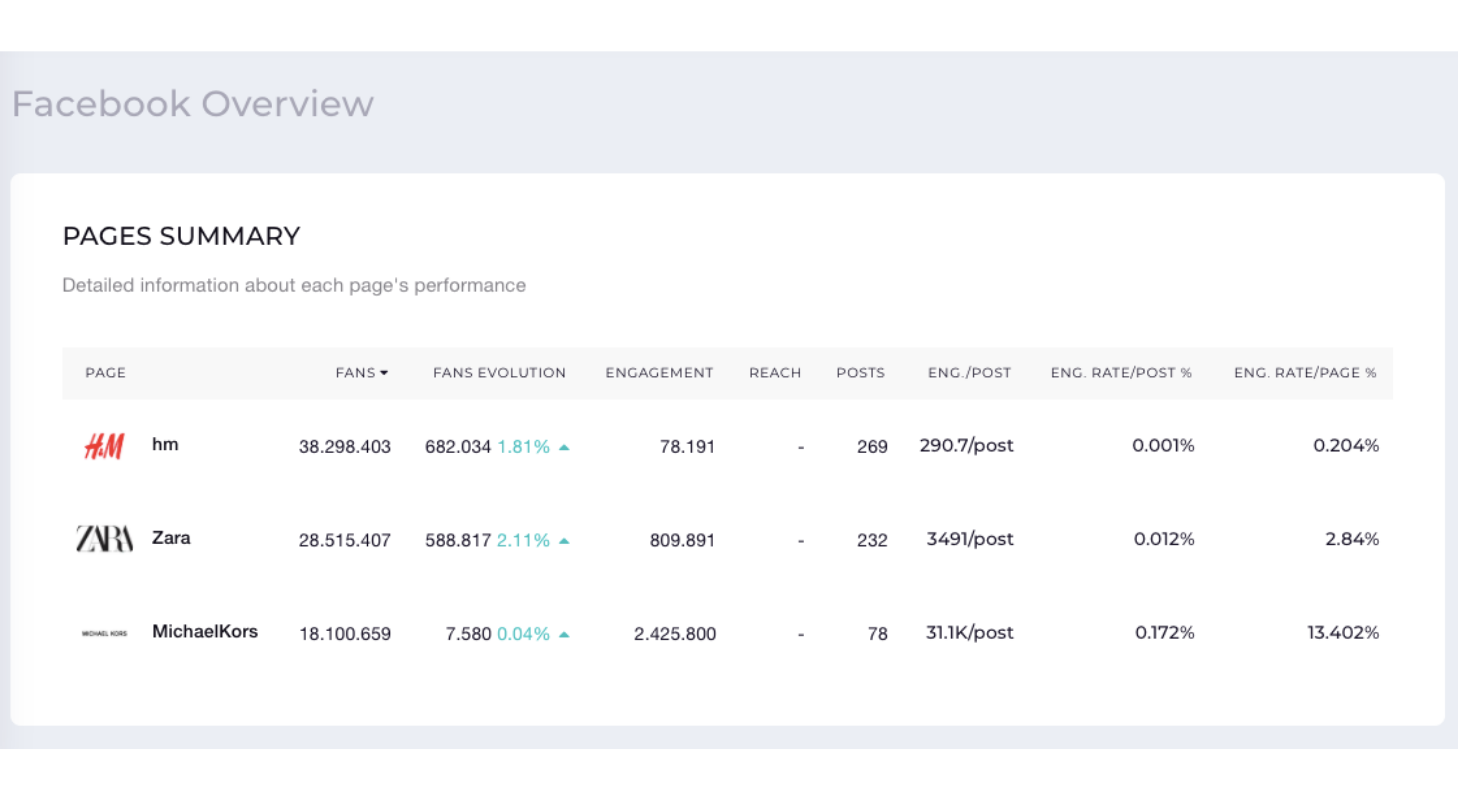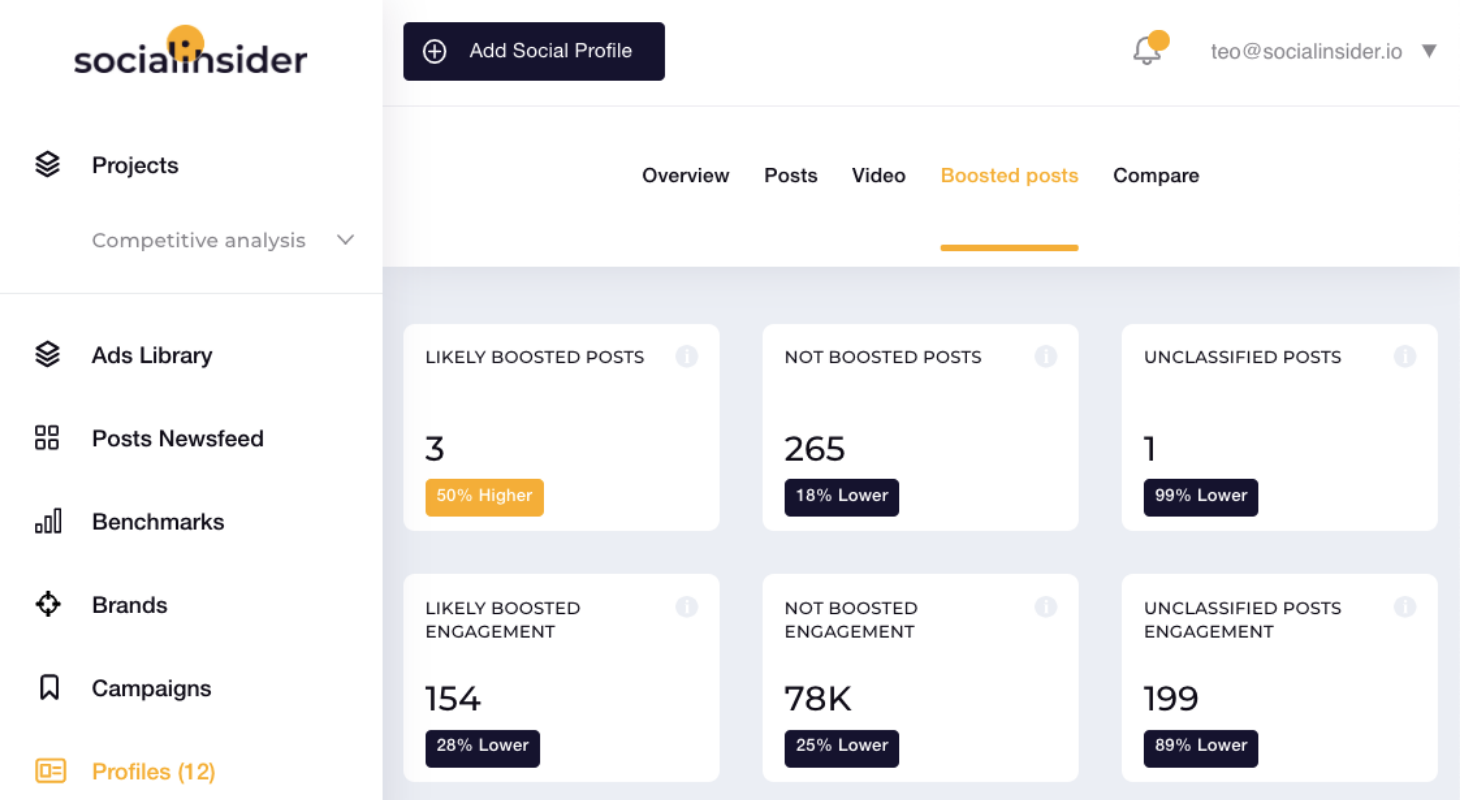A social media competitive analysis helps you stay ahead of your competition on all social media platforms and constantly optimize your content strategy.
Wondering how to perform a social media competitive analysis and where to start?
You've come to the right place.
In this article, I'm going to share with you what benchmarking or competitive analysis means an how to perform a competitive analysis: a step-by-step guide.
To make things easier, you'll find a free social media analysis template that can help you perform your examination faster.
You can start collecting key competitor data and stats - free to download, no email required.
Sit back and relax, it is going to be worth your while. 🚀
In a hurry? 🤔 Download our free social media competitive analysis template
Social media competitive analysis - a complete guide
- What is benchmarking in social media?
- How to perform a social media competitive analysis?
2.1. Know your competition
2.2. Narrow down to top 5 competitors
2.3. Come up with precise competitive analysis goals
2.4. Choose the social media platforms
2.5. Collect stats and data - Create an actionable plan from your analysis
1. What is benchmarking in social media?
Social media benchmarking or competitive analysis are one and the same: analyzing your social media competitors's performance across all platforms and stacking up all the metrics against your own data.
Simply put, a social media competitive analysis it's a side by side comparison between all of yours and your competitor's key metrics to better understand which aspects of your social media strategy can be improved.
2. How to perform a social media competitive analysis?
While extremely necessary, a competitive analysis can be time consuming, especially if you don't have a plan put in place and if you try to include too much information in your report.
Be succinct! Pick your competitors wisely and keep your KPIs in mind.
Here are six easy steps that will help with that⇣
2.1. Know your competition
The first step is identifying your competition. And you should not stop at knowing them; dig deep to know the major platforms they use.
You'll of course know you main competition, but there might be others out there that are worth looking into.
You could simply google your completion through their various niches. Start by typing the industry-based keywords and search for competitors.
❗️Tip: Once you identify one competitor search by using keywords like 'alternative to competitor x'.
If a your business is focused on a local niche, start by searching for regional competition.
When you get the search results, group your competitors using the following three criteria:
- Indirect or direct competitors
It helps you know the competitors with whom you are fighting for the same audience, as well those who indirectly affect your customer base and sell complementary services.
Take our case for example - we could consider Later an indirect competitor because they have an Instagram analytics feature while scheduling is their core feature.
However, when we compare feature by feature, we are looking at competitors like RivalIq or Quintly.
- The level of competition
Are they local, regional, national or global competitors?
It will not make much sense to be running a local pizza joint in a small town and doing an analysis on a global chain like Domino’s.
You will end up with not much data and waste precious time and resources.
That's not to say that you can't pay attention if you see any social media efforts specifically dedicated to your geographical area.
- The audience they appeal to
Another major aspect, somewhat connected with the other two criteria, is the audience.
All your marketing efforts should be tailored to a very specific audience, and this includes social media strategy as well.
If there's another brand out there that sells similar products, but addresses an audience segment that does not match the direction you have for your own brand, then analyzing their performance isn't really relevant to your KPIs.

2.2. Narrow down to the top 5 competitors
Your focus should be on those who are in one way or another outperforming your business.
To successfully identify these top competitors, use these approaches:
- Buyer persona: choose the competitors with the same buyer persona as you have. It helps you focus on the market gap.
- Services offered: look at what type of services they are offering and how yours stand out.
- Business size: choose between - small, medium or large businesses. Search for the customer reach, assets, human resource and any other parameter to help you know how big your competitor’s brand is.
- Locations where businesses are operating. If they are selling physical goods, see where they are located. If they are selling online and they're running the business from different places, understand if it's reasonable to expand your business too. Your social media competitive analysis should be able to answer these questions. It gives you an idea of where you can expand your business to.
Once you know who your competitors are, you can put them all into our handy template.
This spreadsheet be your place where you'll store all of your monthly or quarterly data.

2.3. Come up with precise social media competitive analysis goals
Guide your social media analysis by a set of goals. It helps you steer your social media competitive analysis to the right direction and get meaningful information at the end of the day. Here are some ideas for your social media goals:
- Improve the content strategy
You should know what you are doing right, and what you are not. Get insights into your weak areas on the content strategy.
- Identify suitable ideas for the next campaigns
The oncoming festive season is your time to make great deals. Start looking for ways to amplify your performance and win more customers.
- Competitors’ growth versus yours
How are you faring on market growth? Does the competition outgrow you? Find out what they are doing to keep growing. Implement a digital strategy to maintain a sustainable growth.
You are looking to establish the level of audience engagement your competition has achieved or even hit new heights. It is alright if they are doing way better than you are. Learn their tricks and work your way up.
- Find out the type of content that adequately engages the audience
When it comes social media competitive analysis, the engagement on social media should be one of your primary goals. You want to stay ahead of the competition and learning the perfect way to engage audiences is a crucial aspect.
Knowing your social media needs defines the summary of your analysis and shapes your actions.
Take a look at how these top soft drinks competitors perform on social media!
2.4. Choose the social media platforms
Ok, you have a list of top 5 competitors. Wondering what you should do next?
Choose the channels you'll be monitoring. Focus your social media competitive analysis on what kind of platforms your competition is using to tap into audiences.
Finding the platforms is one thing, but you should know your competitors primarily rely on those platforms.
Establish whether your target audiences use such platforms and, if it's the case, work on a plan to boost your presence on them.
In your social media competitive analysis template, you'll have different tabs dedicated to each social media channel.
Write down your competitors' name, handle or username as well as a link to their profile.
Additionally, add the bio description where you can extract their hashtags or interests by analyzing top keywords used.
Interpreting the texts gives you insights for the future social media campaigns, words you could use in your communication or it defines the topic of interests which are great for the paid campaigns.

Our spreadsheet includes sections for Facebook, Instagram, Twitter, and YouTube.
Extend your analysis, and choose any social networks you’d prefer. You’ll likely notice most brands in your industry have three or four main platforms in common.
2.5. Collect data and stats
What metrics are you looking for?
Picking the right metrics will help you focus on the important areas and bring you closer to achieving your goals.
In this case, here are some metrics you should focus on:
Are your competitors growing their audience quicker than you?
It's recommended to get down to the exact number of followers and fans. It gives you the motivation to work your way up to surpass the competition’s audience figures.
This social media competitive analysis template has different tabs for each platform where you can add the total numbers.
How many posts per day are your competitors publishing on social media?
Take a look at the types of content they post and the frequency.
Choosing the right balance between photos, videos or carousels/albums can have a big impact on your performance.
You can learn a thing or two on what kinds of post people like the best, how captions are written and what CTAs to use, as studies show.
How engaged is the audience on Facebook vs. Instagram vs. Twitter?
You can measure the engagement on social media with the help of a benchmarking tool which offers stats and data for the:
- total engagement
- average engagement
- engagement rate/post
- engagement rate/page or profile
- engagement evolution
Use Socialinsider’s competitor reports to make this process easier and faster!
- Instagram competitors' analysis
- Facebook competitors' analysis
- Twitter competitors' analysis
- YouTube competitors' analysis
- TikTok competitors' analysis
None of the social network gives you insights into competitors' paid campaigns. However there two option to search your competitors ads on Facebook:
- Use Facebook's ads library
Facebook tries to increase transparency and this year they resealed Facebook's Ads Library - a database where you can search by name, topic or organization and you'll get a list with all active and inactive ads campaigns for that specific search.

Other tools to spy on your competitor’s Facebook ads are:
All of the above tools have database with ads where you search through categories and gives you competitive advantage on design or copy.
- Use a benchmark tool which uncover your competitors' boosted content
Keep tabs on your social media competitors' activity with a tool like Socialinsider which shows you what type of content your competitors are boosting and how often.
Are they using branded or non-branded hashtags across their social media platforms?
Dig in to understand why they use the certain kind of tags and whether they are getting good results out of them.
Once you have all the information from your social media competitive analysis, make sure you add that data to your spreadsheet.
3. Create an actionable plan from your social media competitive analysis
This is where the real action begins.
You get to work on your analysis as you build it from down up, sideways, horizontally, as well vertically.
Take keen attention on the insights you draw from your research and analysis. Whatever you do, do not lose sight of your set goals.
Set things in motion using whatever you have learned from the competitors research.
Before finishing your analysis and sending it to managers, follow these steps:
Final thought
It is not rocket science to be a social media marketing guru or make your brand an overnight success story.
As long as you follow this social media competitive analysis template, the rest will be easy.
Take time to reorganize your social media analysis, keep track of your performance, and effect changes when and where necessary.
Your turn. How do you describe the process of competitors' research?
Report and analyze social media performance for multiple business profiles from one dashboard with Socialinsider!
Create social media benchmarks for your clients or industry, generate .pdf or .ppt reports, and automatically send them to clients. - *For users on an Agency plan.










